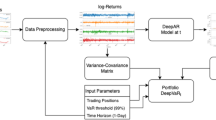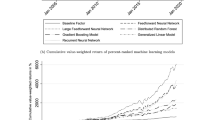Abstract
In this paper, we propose a fuzzy method to investigate the interconnection between equity markets in the form of similar behavior. It has been proved before that the trend cycle of time series can be well estimated using the fuzzy transform. In the suggested method, first, we approximate the local behavior of stocks as a sequence of their trend cycles. Then we measure the distance between these local trend cycles conducting similar practices between different assets. Two experiments are performed to demonstrate the advantages of the suggested method. This method is easy to calculate, well interpretable, and in addition to statistical co-relation, the measure can assist investors in gaining more intuition about the behavior of their assets.









Similar content being viewed by others
Notes
Of course, certain formal requirements must be fulfilled. They are omitted here and can be found in the cited literature.
In general, higher degree F-transform.
Modulus of continuity is in our case defined as \(\omega (h, { T\!C})=\max _{\begin{array}{c} |x-y|<h\\ x,y\in [c_1, c_{n-1}] \end{array}}|{ T\!C}(x)-{ T\!C}(y)|\).
A t-norm is a special operation that in fuzzy logic models logical conjunction.
It is necessary to emphasize, that we can work with estimations \({ \widetilde{T\!C}}_X\) and \({ \widetilde{T\!C}}_Y\) of the trend cycle only, because we do not know the real ones.
https://www.nasdaq.com/Second footnote
https://www.nasdaq.com/Second footnote.
References
Anděl J (1976) Statistical analysis of time series. SNTL, Praha ( (in Czech))
Bekaert G, Harvey CR (2003) Market integration and contagion. Tech. rep. National Bureau of Economic Research
Bernanke B (2016) The relationship between stocks and oil prices. Ben Bernanke’s Blog on Brookings posted on February, vol 19
Cha B, Oh S (2000) The relationship between developed equity markets and the pacific basin’s emerging equity markets. Int Rev Econ Finance 9(4):299–322
Chan WS (2003) Stock price reaction to news and no-news: drift and reversal after headlines. J Financ Econ 70(2):223–260
Davies DL, Bouldin DW (1979) A cluster separation measure. IEEE Trans Pattern Anal Mach Intell 2:224–227
Devlin SJ, Gnanadesikan R, Kettenring JR (1975) Robust estimation and outlier detection with correlation coefficients. Biometrika 62(3):531–545
Eun CS, Shim S (1989) International transmission of stock market movements. J Financ Quantitat Anal 24(2):241–256
Fu T-C (2011) A review on time series data mining. Eng Appl Artif Intell 24(1):164–181
Granger CW (1969) Investigating causal relations by econometric models and cross-spectral methods. Econometrica J Econ Soc, pp 424–438
Granger CW (1980) Testing for causality: a personal viewpoint. J Econ Dyn Control 2:329–352
Hamao Y, Masulis RW, Ng V (1990) Correlations in price changes and volatility across international stock markets. Rev Financial Stud 3(2):281–307
Hamilton J (1994) Time series analysis. Princeton University Press, Princeton
Han J, Pei J, Kamber M (2011) Data mining: concepts and techniques. Elsevier, Amsterdam
Herbst AF, McCormack JP, West EN (1987) Investigation of a lead-lag relationship between spot stock indices and their futures contracts. J Futures Markets 7(4):373–381
Hilliard JE (1979) The relationship between equity indices on world exchanges. J Finance 34(1):103–114
Hou K (2007) Industry information diffusion and the lead-lag effect in stock returns. Rev Financial Stud 20(4):1113–1138
Kaufman L, Rousseeuw PJ (2009) Finding groups in data: an introduction to cluster analysis, vol 344. Wiley, Hoboken
Keogh E, Kasetty S (2003) On the need for time series data mining benchmarks: a survey and empirical demonstration. Data Mining knowl Discovery 7(4):349–371
Kullmann L, Kertész J, Kaski K (2002) Time-dependent cross-correlations between different stock returns: a directed network of influence. Phys Rev E 66(2):026125
Liao TW (2005) Clustering of time series data-a survey. Pattern Recognit 38(11):1857–1874
Lo AW, MacKinlay AC (1990) When are contrarian profits due to stock market overreaction? Rev Financial Stud 3(2):175–205
Mandel L, Wolf E (1976) Spectral coherence and the concept of cross-spectral purity. JOSA 66(6):529–535
Martens M, Poon S-H (2001) Returns synchronization and daily correlation dynamics between international stock markets. J Bank Finance 25(10):1805–1827
McQueen G, Pinegar M, Thorley S (1996) Delayed reaction to good news and the cross-autocorrelation of portfolio returns. J Finance 51(3):889–919
Mech TS (1993) Portfolio return autocorrelation. J Financial Econ 34(3):307–344
Mining WID (2006) Data mining: Concepts and techniques. Morgan Kaufinann
Mirshahi S, Novák V (2020) A fuzzy approach for similarity measurement in time series, case study for stocks. In: International conference on information processing and management of uncertainty in knowledge-based systems, Springer, pp 567–577
Morse MD, Patel JM (2007) An efficient and accurate method for evaluating time series similarity. In: Proceedings of the 2007 ACM SIGMOD international conference on Management of data, ACM, pp 569–580
Nguyen L, Novák V (2015) Filtering out high frequencies in time series using F-transform with respect to raised cosine generalized uniform fuzzy partition. In: Proc. Int. Conference FUZZ-IEEE, Istanbul. IEEE Computer Society, CPS, p 2015
Nguyen L, Novák V (2018) Forecasting seasonal time series based on fuzzy techniques. Fuzzy Sets and Systems, (to appear)
Novák V, Perfilieva I, Močkoř J (1999) Mathematical principles of fuzzy logic. Kluwer, Boston
Novák V, Štěpnička M, Dvořák A, Perfilieva I, Pavliska V, Vavříčková L (2010) Analysis of seasonal time series using fuzzy approach. Int J General Syst 39(3):305–328
Novák V, Perfilieva I, Holčapek M, Kreinovich V (2014) Filtering out high frequencies in time series using f-transform. Inf Sci 274:192–209
Novák V, Perfilieva I, Dvořák A (2016) Insight into fuzzy modeling. Wiley, Hoboken
Roll R (1992) Industrial structure and the comparative behavior of international stock market indices. J Finance 47(1):3–41
Serra J, Arcos JL (2014) An empirical evaluation of similarity measures for time series classification. Knowl Based Syst 67:305–314
Statman M, Scheid J (2008) Correlation, return gaps, and the benefits of diversification. J Portfolio Manage 34(3):132–139
Vlachos M, Hadjieleftheriou M, Gunopulos D, Keogh E (2006) Indexing multidimensional time-series. VLDB J 15(1):1–20
Wang PE (ed) (2001) Computing with Words. J. Wiley, New York
Wang Y, Wei Y, Wu C (2010) Cross-correlations between chinese a-share and b-share markets. Physica A Stat Mech Appl 389(23):5468–5478
Wang X, Mueen A, Ding H, Trajcevski G, Scheuermann P, Keogh E (2013) Experimental comparison of representation methods and distance measures for time series data. Data Mining Knowl Discovery 26(2):275–309
Wu C, Su Y-C (1998) Dynamic relations among international stock markets. Int Rev Econ Finance 7(1):63–84
Zervas G, Ruger SM (1999) The curse of dimensionality and document clustering
Acknowledgements
The paper has been supported by the grant 18-13951S of GAČR, Czech Republic.
Author information
Authors and Affiliations
Contributions
All authors contributed to the study conception and design. Material preparation, data collection and analysis were performed by Soheyla Mirshahi and Vilém Novák. The first draft of the manuscript was written by both authors, and all authors commented on previous versions of the manuscript. All authors read and approved the final manuscript.
Corresponding author
Ethics declarations
Conflict of interest
The authors declare that they have no conflict of interest.
Human and animal rights
This article does not contain any studies with human participants or animals performed by the authors.
Additional information
Communicated by Vladik Kreinovich.
Publisher's Note
Springer Nature remains neutral with regard to jurisdictional claims in published maps and institutional affiliations.
Rights and permissions
About this article
Cite this article
Mirshahi, S., Novák, V. A fuzzy method for evaluating similar behavior between assets. Soft Comput 25, 7813–7823 (2021). https://doi.org/10.1007/s00500-021-05639-y
Published:
Issue Date:
DOI: https://doi.org/10.1007/s00500-021-05639-y




